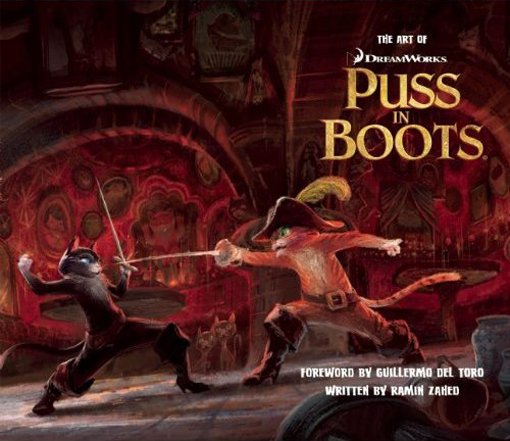Review: 'The Art of Puss in Boots', by Ramin Zahed
This coffee-table art book is officially published on November 1, shortly after the movie is released (Oct. 28); but the publisher sent me an advance review copy (Oct. 21). So I haven’t seen the movie yet. But we have seen its publicity for the last couple of months: the posters, the multiple trailers, the viral videos like “The Cat Haz Swagger” and “’No Pants’ Pants” that emphasize the hunky Puss and his new feline femme fatale, Kitty Softpaws – so we can be sure that this is a very Furry movie.
 If they didn’t want to call this The Art of DreamWorks Puss in Boots, they shouldn’t’ve put the DreamWorks logo in the middle of the book’s title.
If they didn’t want to call this The Art of DreamWorks Puss in Boots, they shouldn’t’ve put the DreamWorks logo in the middle of the book’s title.Come to think of it, coffee-table “The Art of …” publicity books about animated features have been common for the last few years. It’s strange that there hasn’t been more notice in Furry fandom of those dominated by Furry characters, like Ratatouille, Madagascar, or the Kung Fu Panda movies. Oh, well.
The writer of The Art of Puss in Boots is Ramin Zahed, the veteran Editor-In-Chief of the industry’s 10-yearly Animation Magazine, who “has been covering the animation and visual effects world for over 15 years.” That statement has been part of his canned biography since at least mid-2005, so it is well over fifteen years by now. Some of his other animation writing credits include Variety and Hollywood Reporter and newspapers like the Los Angeles Times.
But if you look at the last page, there are also credits for a Producer, an Art Director, a Designer, and others. It is clear that this book is not the work of Zahed alone, but is a product of DreamWorks Animation’s publicity department.
The adulatory text leaves little doubt of this:
“The details of each character design, location, and plot point were meticulously polished, tested, and perfected to enhance the glorious world of our feline adventurer.” (p. 15), is a typical gushing comment. [Ed: There's more in this excerpt.]
But nobody reads these animation art books for the text, except for the details in the text:
“First designed by Tom Hester for ‘Shrek 2’, Puss was partially based on cats owned by ‘Shrek’ director Arthur Adamson and visual effects supervisor Ken Bielenberg.” (p. 27) — “After Antonio Banderas was cast in the role, the animation team studied the Spanish actor’s performance in the 1998 movie ‘The Mask of Zorro’ for inspiration.” (ibid.)
Once the decision was made for the Shrek movies to model Puss to play off of Banderas’ Spanish background, it became natural to use Spanish and Latin American imagery for this prequel about Puss’ early years before he joined the Shrek cast. This is a departure from the traditional French look inspired by Charles Perrault’s 1697 Master Cat; or, The Booted Cat, the standard ‘fixed’ version of the ancient European oral folk tale. The artists’ inspiration for each of the major and minor characters is told, for readers who want all of the details.
What this book emphasizes is, as the title says, The Art of Puss in Boots. There is art on every page; some are nothing but art. There are almost no finished frames from the movie, very few black-&-white storyboards, and only a few more monochromatic pencil sketches. Instead, the art is almost all in full color; preliminary character designs, background and set designs, matte paintings, and related mostly-digital art. There are also chapters on how the computerized visual elements (surfacing, lighting, VFX, etc.) were composited into the finished film. Each image is credited to the production artist who drew it. Most of the imagery is by lead character designer Patrick Maté and his staff. (The digital sketch used as this book’s cover, from the Cat Cantina sequence, is by Ronald A. Kurniawan.)
The movie’s plot is made clear by the presentation of the graphics. Puss and Humpty Dumpty are childhood friends from the orphanage of San Ricardo. After they grow up and leave the orphanage, they separate. Years later, after Puss has become a notorious adventurer, Humpty Dumpty rejoins him to propose a joint venture: to find and climb the beanstalk into the sky and steal the Giant’s golden goose, making themselves rich. They meet competition from villains Jack & Jill who try to eliminate them, and from feline adventuress Kitty Softpaws, who insists on joining them.
There are plenty of topical picture books about the story of the movie, or new stories featuring Puss. But if you are interested in the movie, and in how its imagery came to be created – whether you are a Furry fan or an animation fan – you have to have this book.
“The Art of [DreamWorks] Puss in Boots”, by Ramin Zahed, foreword by Guillermo Del Toro.
Insight Editions, November 2011, illustrated hardcover $39.95 (152 pages).
About the author
Fred Patten — read stories — contact (login required)a retired former librarian from North Hollywood, California, interested in general anthropomorphics
Comments
WE THANK THEE FOR THIS WONDERFUL ARTICLE.
Thank you for the insight! I've been looking forward to this book for over a month now..!
Post new comment